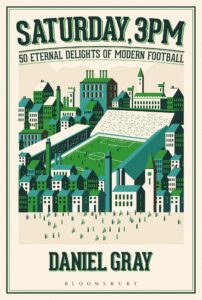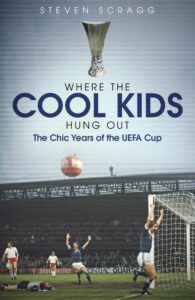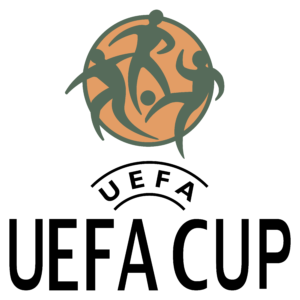Book Review: Fierce Genius: Cruyff’s Year at Feyenoord by Andy Bollen
 If you engaged a football fan in word association, throwing them the name ‘Johan Cruyff’, the most expected response would be ‘Ajax’, the club he successfully played and managed and with which he is most readily associated. You might also get a few replying ‘Holland’, ‘Total Football’ or ‘14’ the number famously worn by the Dutch legend, or even ‘Barcelona’, like Ajax a club he won honours with both as a player and coach. Some may even respond ‘turn’ as in the ‘Cruyff Turn’, which originated when he twisted Swedish defender Jan Olsson inside out during their World Cup game in 1974. What is highly unlikely is that any would be prompted to say ‘Feyenoord’ – the reason? Well, Cruyff’s farewell season in 1983/84, playing for the Rotterdam based club, despite the club winning the ‘double’ (Eredivisie and KNVB Cup), is largely forgotten about, amongst all else that Cruyff achieved. Andy Bollen’s Fierce Genius: Cruyff’s Year at Feyenoord, therefore, is a welcome window on this period about Amsterdam’s most famous footballing son.
If you engaged a football fan in word association, throwing them the name ‘Johan Cruyff’, the most expected response would be ‘Ajax’, the club he successfully played and managed and with which he is most readily associated. You might also get a few replying ‘Holland’, ‘Total Football’ or ‘14’ the number famously worn by the Dutch legend, or even ‘Barcelona’, like Ajax a club he won honours with both as a player and coach. Some may even respond ‘turn’ as in the ‘Cruyff Turn’, which originated when he twisted Swedish defender Jan Olsson inside out during their World Cup game in 1974. What is highly unlikely is that any would be prompted to say ‘Feyenoord’ – the reason? Well, Cruyff’s farewell season in 1983/84, playing for the Rotterdam based club, despite the club winning the ‘double’ (Eredivisie and KNVB Cup), is largely forgotten about, amongst all else that Cruyff achieved. Andy Bollen’s Fierce Genius: Cruyff’s Year at Feyenoord, therefore, is a welcome window on this period about Amsterdam’s most famous footballing son.
In terms of the format of the book, Bollen does not simply focus on that campaign back in the early 1980s but provides a wider view as he looks across Cruyff’s career as player and coach in Holland, Spain and in America, as well as portraying something of his character and temperament. This means that the triumphant season at Feyenoord, is dealt with in just six chapters (out of thirty-one), with five focusing on the league matchdays and one detailing the Cup win. The emphasis of these six chapters is very much around match detail with description of the major incidents of the games, drawn it feels from the many videos available on YouTube, and incidentally well worth a watch to fully appreciate the genius of Cruyff. If there is a disappointment it is that those chapters on that season don’t contain more interviews and opinions from that campaign, whether that be coaches, players, administrators, fans or the media, to get more reflection and insight on an incredible achievement. Indeed it is not really until the final chapter, that more context is provided on the events of the 1983/84 Eredivisie.
However, that aside, this is a very informative and readable portrayal which Bollen relates with humour and as it evident from the writing, from the authors position as a fan of Cruyff. The chapters woven around the 1983/84 season take the reader from Cruyff the boy growing up in Amsterdam, through his first playing spell at the De Meer Stadion from 1964 to 1973, his five year stint in Spain with Barcelona, brief sojourns in the USA playing in the NASL and Spain with Levante, before a second spell at Ajax in which Cruyff delivered leagues titles in 1981/82 and in the following season. At the end of that campaign, in which Ajax also won the Cup, Cruyff was 36 and the expectation was that he would get a further one-year deal and retire at the club.
However, as Bollen details, this didn’t come to pass and instead Cruyff made the forty-odd miles journey from Amsterdam to Rotterdam, joining Ajax’s bitterest rivals, Feyenoord, capturing the ‘double’ for De Trots van Zuid and winning Dutch Footballer of the Year for himself. Once he retired from playing, Cruyff showed that his genius wasn’t just restricted to playing as coaching roles at Ajax and Barcelona brought national and European success taking and developing ‘Total Football’ to a new level, with his influence today seen for example in the managerial style of Pep Guardiola and a lasting legacy on the youth set-up and systems at both de Godenzonen and Barça.
For all the positives that Cruyff brought to the game, Bollen is balanced in acknowledging that the Dutchman had his faults and weaknesses. For instance, not everyone was comfortable with Cruyff’s continual drive for perfection or his stubbornness and sometimes forthright views, whether on or off the pitch, aimed at teammates, coaches, the media and football administrators alike. Indeed, Bollen recognises that this side of his character was undoubtedly instrumental in Cruyff lose a captaincy vote by the Ajax squad in 1973 and was no doubt influential in him not becoming coach of the Dutch national side.
The nearest Cruyff got to being an international manager was his time from 2009 to 2013 when he was in charge of Catalonia and which turned out to be his last job in the game. Sadly, Cruyff lost his battle with lung cancer and died on 24 March 2016 – the Fierce Genius was gone. He will though be remembered as long as football is played.
If you look at the greatest players in history, most of them couldn’t coach. If you look at the greatest coaches in history, most of them were not great players. Johan Cruyff did both – and in such an exhilarating style. (Former Ajax and Dutch international Johan Neeskens)
(Pitch Publishing. February 2021. Hardback 288 pages)
 Even before turning over one single page this is a book that demands attention due to the dazzling and eye-catching cover design, intriguing title and eye-watering size.
Even before turning over one single page this is a book that demands attention due to the dazzling and eye-catching cover design, intriguing title and eye-watering size. Football and fiction – not always the best of teammates, however, There’s Only One Danny Garvey by David F. Ross is a brilliant exception.
Football and fiction – not always the best of teammates, however, There’s Only One Danny Garvey by David F. Ross is a brilliant exception. Having recently rattled through Daniel Gray’s
Having recently rattled through Daniel Gray’s  Choosing fifty moments that define football seems generous enough on the face of it, but when it comes down to a sport that has been in existence for over 150 years, things aren’t quite so clear-cut. So, hats off to Ben Jones and Gareth Thomas – writers of
Choosing fifty moments that define football seems generous enough on the face of it, but when it comes down to a sport that has been in existence for over 150 years, things aren’t quite so clear-cut. So, hats off to Ben Jones and Gareth Thomas – writers of  Although published in 2016, Daniel Gray’s Saturday, 3PM couldn’t be more fitting for the current times. Ask any football fan what they’re missing about matches played behind closed doors or the entire absence of football in the lower leagues and they’ll reel off a selection of things that Gray includes in this book of his ‘fifty eternal delights of modern football’.
Although published in 2016, Daniel Gray’s Saturday, 3PM couldn’t be more fitting for the current times. Ask any football fan what they’re missing about matches played behind closed doors or the entire absence of football in the lower leagues and they’ll reel off a selection of things that Gray includes in this book of his ‘fifty eternal delights of modern football’. At the point this review was written in February 2020, Leicester City sat third in the Premier League, and were considered by many to be an established top-flight club, having taken the title in a never to be forgotten 2015/16 campaign. Go back though to May 1991 and The Foxes were on the brink of dropping into the third tier of the English game but saved themselves with a last day victory at their former home, Filbert Street, with a win over Oxford United.
At the point this review was written in February 2020, Leicester City sat third in the Premier League, and were considered by many to be an established top-flight club, having taken the title in a never to be forgotten 2015/16 campaign. Go back though to May 1991 and The Foxes were on the brink of dropping into the third tier of the English game but saved themselves with a last day victory at their former home, Filbert Street, with a win over Oxford United. For some people (me included), the mere mention of the periodic table may bring them out in a rash or at least induce a feeling of dread. Thankfully, there’s no confusing chemistry or strange isotopes in Nick Holt’s The Periodic Table of FOOTBALL, which finally succeeds in making the periodic table understandable, relevant and, dare I say it, fun (apologies to all chemistry fans out there who rather like the original).
For some people (me included), the mere mention of the periodic table may bring them out in a rash or at least induce a feeling of dread. Thankfully, there’s no confusing chemistry or strange isotopes in Nick Holt’s The Periodic Table of FOOTBALL, which finally succeeds in making the periodic table understandable, relevant and, dare I say it, fun (apologies to all chemistry fans out there who rather like the original). Back in September 2019,
Back in September 2019,  As with the Cup Winners’ Cup, changes to the UEFA Cup came about through the breakup of the former Communist bloc, necessitating the introduction of a Preliminary Round to the competition. With the two-legged Finals gone in 1996/97 the first steps of change arrived, as the Final morphed into a one-off game at a neutral venue. Further transformation came with the Cup Winners’ Cup demise at the end of 1998/99, and the Groups Stages established in the competition in 2004/05, with the ‘rebrand’ complete in 2009/10. Part of this includes those clubs failing to qualify for the Champions League knock-out stages dropping into the Europa League, which as Scragg acknowledges gives the impression of it being a second-rate competition. As he so brilliantly puts it, “essentially the Europa League is the MK Dons of European club football tournaments. There is a sad sense of franchise about it.”
As with the Cup Winners’ Cup, changes to the UEFA Cup came about through the breakup of the former Communist bloc, necessitating the introduction of a Preliminary Round to the competition. With the two-legged Finals gone in 1996/97 the first steps of change arrived, as the Final morphed into a one-off game at a neutral venue. Further transformation came with the Cup Winners’ Cup demise at the end of 1998/99, and the Groups Stages established in the competition in 2004/05, with the ‘rebrand’ complete in 2009/10. Part of this includes those clubs failing to qualify for the Champions League knock-out stages dropping into the Europa League, which as Scragg acknowledges gives the impression of it being a second-rate competition. As he so brilliantly puts it, “essentially the Europa League is the MK Dons of European club football tournaments. There is a sad sense of franchise about it.”
